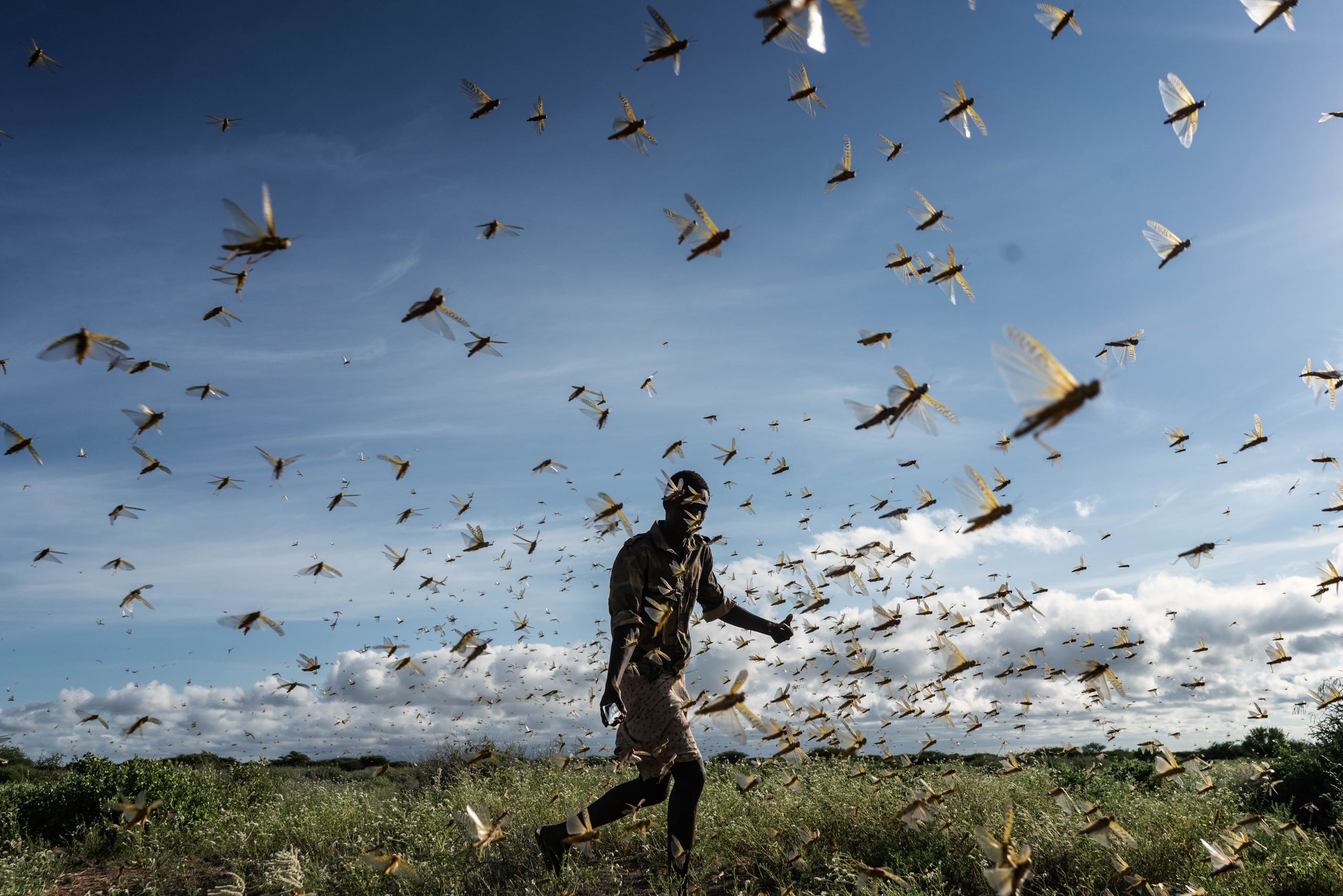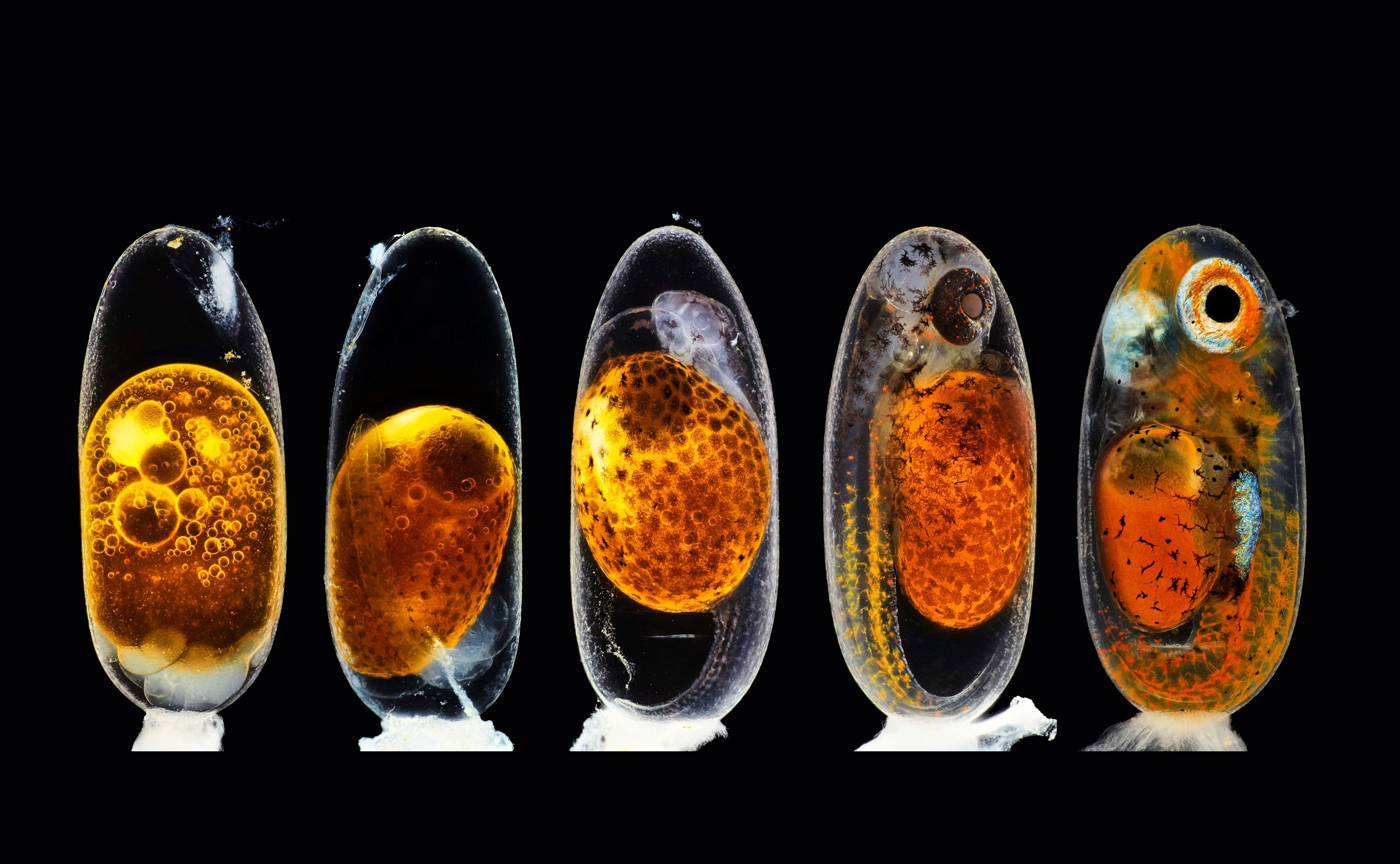The best science images of 2020
A new virus, wafer-thin solar cells, gene‑edited squid and more.

Text by Nisha Gaind, images selected by Nature’s visuals team
2020 has been a year like no other. The COVID-19 pandemic pushed science to the forefront and dominated lives. But the year also produced fresh images unrelated to the virus. From wafer-thin solar cells to gene-edited squid, here are the striking shots from science that caught the eye of Nature’s news and art team.

Credit: Daniel Knop/Nikon Small World
Credit: Daniel Knop/Nikon Small World
Send in the clown. An embryonic clownfish (Amphiprion percula) grows inside its egg. These remarkably detailed pictures were captured on days one, three, five and nine of its development; the first was taken hours after fertilization. Photographer Daniel Knop won second place in Nikon’s Small World competition for photomicrography.

Power bubble. Materials scientists at King Abdullah University of Science and Technology in Thuwal, Saudi Arabia, used an inkjet printer to make solar cells so thin and light that they can rest on a soap bubble. They created the cells from layers of ‘ink’, including a conductive polymer called PEDOT:PSS that formed the electrodes.

Credit: NSO/NSF/AURA
Credit: NSO/NSF/AURA
On the surface. This is the highest-resolution image ever taken of the Sun from Earth. Captured by the world’s most powerful solar telescope, the Daniel K. Inouye Solar Telescope in Hawaii, and released in January, it shows ‘cells’ of plasma rising from inside the star. The dark borders indicate where plasma is cooling and sinking.

Credit: Chris Bakal and Nick Moser
Credit: Chris Bakal and Nick Moser
Cutting cancer. This cancer cell has been slashed open using an ion beam. The beam has blasted part of the cell away to reveal a cross section and has cut a triangular shape into the silica substrate surface on which it rests. The technique, called ion-beam milling, allows researchers to look inside cancer cells in unprecedented detail.

Credit: Mohd Rasfan/AFP/Getty
Credit: Mohd Rasfan/AFP/Getty
Protection vs pollution. Monkeys in Malaysia hold a medical mask. Protective wear has become a part of daily life for many amid the coronavirus pandemic. Environmentalists worry that disposable items are adding heavily to plastic pollution

The seventh crown. A coronavirus (artist’s visualization) became 2020’s biggest story as it caused a devastating pandemic. SARS-CoV-2 is the seventh coronavirus known to infect humans.

Credit: Karen Crawford
Credit: Karen Crawford
Invisible ink. In July, researchers reported that they had made squid transparent with gene editing. They used CRISPR–Cas9 to delete a gene called TDO from embryos of longfin inshore squid (Doryteuthis pealeii). The TDO protein adds pigment to the animals’ eyes and to colour-changing cells used for camouflage.

Scarred sky. Light trails from moving satellites score this photograph of a star. Companies are launching thousands of craft into orbit to provide people with Internet access, but astronomers are concerned about how sunlight reflected off satellites will interfere with observations.
The great north. Scientists on the biggest research expedition ever to the Arctic take atmospheric measurements of temperature, humidity and water vapour. The MOSAiC mission has yielded unprecedented data on the north’s climate.

Credit: R.P. Doherty et al./Soft Matter
Credit: R.P. Doherty et al./Soft Matter
Smooth sailing. This boat-shaped particle is 30 micrometres long and can propel itself using a chemical reaction. Researchers 3D-printed the particle and coated it with metal. This catalyses a reaction in the hydrogen peroxide solution in which the particle sits, to produce gas that pushes it along.

Hair raising. This knobbled surface is human skin — complete with hair follicles — that has been grown from scratch using ‘pluripotent’ stem cells that can develop into any cell type. Researchers hope that this kind of lab-grown skin will aid disease research and improve reconstructive surgery such as skin grafts.

Credit: Adrees Latif/Reuters
Credit: Adrees Latif/Reuters
Seeing red. Red fire retardant surrounds a team searching for people in burnt houses in Talent, Oregon, in September. The western United States suffered one of its worst wildfire seasons on record this year. Researchers suggest that climate change is exacerbating conditions that can stoke wildfires.
A personal view of the news
In compiling this year’s collection of stunning science photographs, Nature’s media and news editors identified an image that said something special to them. Here is their take on the past 12 months.
Facing the inferno. Jessica Hallett (Associate media editor). This unique perspective of the El Dorado Fire in California stood out to me among the thousands of wildfire images this year. The fire was sparked by a malfunctioning pyrotechnic device at a party on 5 September, and burnt more than 9,000 hectares of land. This image struck me for many reasons — but the blaze reflected in the firefighter’s glasses really helped me to process the intensity and power of these fires, and the devastation that a simple careless act can cause. Credit: Terry Pierson/Orange County Register/ZUMA Wire
Longed-for reunion. Lizzy Brown (Managing media editor). Beautiful photography from the MOSAiC mission to the Arctic has been capturing our attention all year, but this photo in particular stood out to me. It shows the first-leg team returning on the research vessel Kapitan Dranitsyn. Photographer Esther Horvath was there to capture the poignant moment when, after 3.5 months in the central Arctic Ocean in the polar night, the team finally entered daylight on 1 January, and with that had a phone connection again. Expedition members gathered on the bridge of the vessel to contact their families by video call, seeing them for the first time in months. Credit: Esther Horvath
Shoots of hope. Amelia Hennighausen (US media editor). In the past few years, wildfires have caused devastation with an intensity and frequency never documented before, particularly in the northwestern United States, the Arctic and Brazil. The catastrophic damage from these infernos conveys how vulnerable we are to climate change. But just as I could no longer look at another ruinous firestorm, I saw this: regrowth in redwood trees sprouting two months after a blazing wildfire in Big Basin Redwoods State Park, California. For the first time in 2020, I saw renewal is possible. Credit: Frans Lanting
Spark of destruction. Tom Houghton (Media editor). This incredibly powerful moment — a lightning strike during the Taal Volcano eruption in the Philippines back in January — looks like a dramatic oil painting by a nineteenth-century artist. Volcanic lightning is an incredible phenomenon caused by static electricity generated from ash particles colliding in the volcano plume. It results in the most breathtaking examples of destructive power. Credit: Domcar C Lagto/PACIFIC P/SIPA/Shutterstock
Life triumphant. Agnese Abrusci (Media editor). Since the coronavirus pandemic broke, we have seen a tremendous amount of hospital pictures evoking death, but this one — celebrating life, for a change — really caught my eye. With mesmerising chiaroscuro worthy of sixteenth-century Italian painter Caravaggio, this photo of a nurse handing a premature newborn child to his mother resonates powerfully with the distance between family and patients, their solitude, the challenge of being a parent during the pandemic. But above all, it reminds us that despite all that has happened worldwide during this annus horribilis, the wonder of life still goes on. Credit: Hannah McKay/Reuters
Signup for the free daily Nature Briefing.
An essential round-up of science news, opinion and analysis, free in your inbox every weekday.
